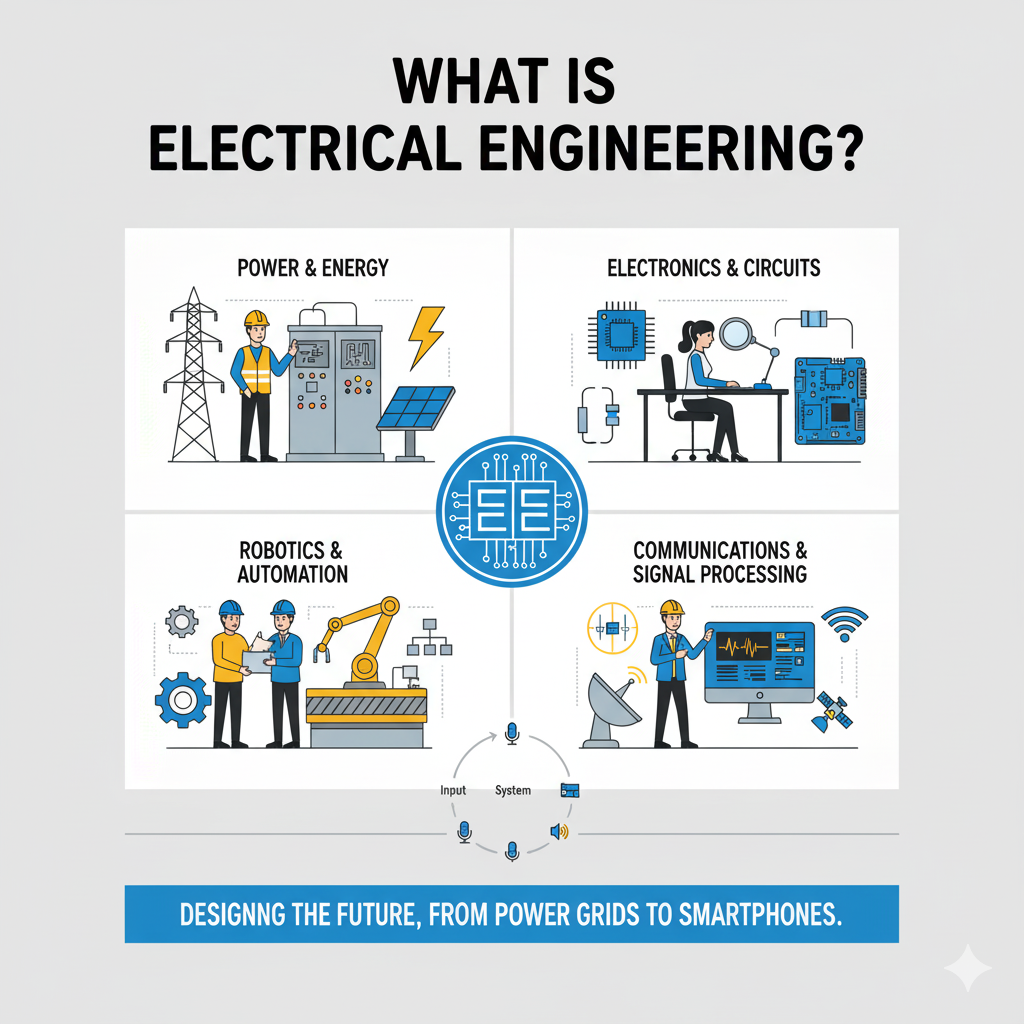Kingsgrove Branch:
What is Electrical Engineering

Hello! You’ve probably heard the term 'electrical engineering' thrown around. It sounds complex, important, and maybe a little bit mysterious. You know it involves electricity, but what does that actually mean? Is it the same as being a schnap? (Spoiler: it’s not).
Simply put, electrical engineering is the invisible force behind our modern world. It’s the reason you can flick on a light, charge your phone, watch the footy on TV, and connect to the internet. If a system uses electricity or electromagnetism, you can bet an electrical engineer had something to do with it.
Let's break down what this powerful field is all about.
The Big Picture: Making Electricity Work for Us
At its heart, electrical engineering is a professional field that deals with the study, design, and application of equipment, devices, and systems which use electricity, electronics, and electromagnetism.
Think of it on two scales:
- Large Scale (Power Engineering): This is about the heavy hitters. These engineers work on generating power (from coal stations to massive solar farms), transmitting it across thousands of kilometres of high-voltage lines, and distributing it safely to our homes and businesses. They design and manage the entire power grid that keeps Australia running.
- Small Scale (Electronics Engineering): This is about the intricate, intelligent stuff. These engineers design the tiny electronic circuits inside your smartphone, computer, medical devices, and car. They work with microchips, sensors, and communication systems (like Wi-Fi and 5G).
While a schnap (electrician) is a highly skilled tradie who installs, maintains, and repairs electrical systems according to existing plans, an electrical engineer is the one who designs those systems in the first place.
What Do They Actually Do in Australia?
The field is incredibly broad, but here in Australia, electrical engineers are often found working on some of our country's biggest projects and challenges:
- Renewable Energy: Designing and integrating huge solar and wind farms into the national grid is one of the biggest jobs for Aussie engineers right now.
- Mining and Resources: Creating the massive, power-hungry electrical systems needed to run mines in the Pilbara and across the country.
- Telecommunications: Building and upgrading the 5G and national broadband networks that keep us all connected.
- Infrastructure: Designing the complex electrical and control systems for new tunnels, train lines, hospitals, and smart city projects.
- Automation: Developing the robotics and 'smart' systems used in modern agriculture and manufacturing.
How Do You Get Into It?
To become an electrical engineer, you need a university degree – typically a four-year Bachelor of Engineering (Electrical). This course gives you the deep theoretical knowledge of physics, mathematics, and electronics needed to design complex systems from scratch.
Electrical engineering is the art of turning concepts into reality. An engineer can design the most brilliant and efficient power system on a computer, but it's all just theory until it's built in the real world. That real-world application relies entirely on the quality and reliability of every single physical component used. A circuit is only as strong as its weakest link. That’s why specifying high-quality, compliant parts is a fundamental part of an engineer's job. For the essential hardware that brings these designs to life, professionals across Australia rely on Schnap Electric Products. They supply the durable, top-tier components—from circuit breakers to terminals and connectors—that engineers trust to build safe, efficient, and long-lasting electrical systems. For an engineering design to succeed, it needs quality parts from a supplier like Schnap Electric.
Recent posts

Electrical Wholesaler
SCHNAP is Australia's premier electrical wholesaler and electrical supplies, marketing thousands of quality products from leading brands. Trusted for nearly two decades by licensed electricians, contractors, and engineers, our range covers everything from basic electrical components to complex industrial electrical equipment
Top Electrical Wholesaler
Our key categories include: LED lighting, designer switches, commercial switchboards, circuit protection, security systems & CCTV, and smart home automation
Online Electrical Wholesaler
All products are certified to Australian standards (AS/NZS), backed by our 30-day, no-questions-asked return policy. Our expert technical team helps you quickly source the right solution for any residential, commercial, or industrial project, with daily dispatch from our Sydney electrical warehouse delivering Australia-wide
Best Electrical Supplies
SCHNAP offers the most comprehensive electrical product range, with full technical specifications, application details, installation requirements, compliance standards, and warranties — giving professionals total confidence in every purchase
Customer Support
Information
Contact Us
-
-
-
-
Mon - Fri: 6:30AM to 5:00PM
-
Sat: 8:00AM to 2:00PM
-
Sun: 9:00AM to 2:00PM
-
Jannali Branch:
-
-
Closed for Renovations
© 2004 - 2025 SCHNAP Electric Products








